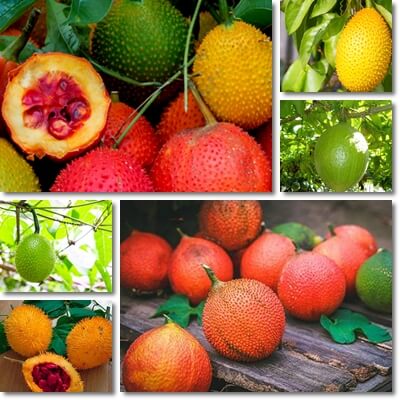Gac, scientific name: Momordica cochinchinensis, is a fruit native to Southeast Asia and an important source of dietary lycopene and beta-carotene, two pigmented antioxidants with anticancer and immune system boosting properties.
Eating gac is good for eyesight, with benefits for visual acuity and color vision, and helps lower blood pressure numbers that are too high.
The fruit is a source of fatty acids and vitamin E which help support memory and learning, boast cardiovascular benefits and boost skin health.
The fatty acids in the fruit further help increase the absorption of fat-soluble vitamins from other dietary sources, helping reverse avitaminosis in both children and adults.
Research has found the pulp contains a protein with antitumor activity, adding to the benefits of eating gac fruit.

What is gac?
Momordica cochinchinensis, commonly known as gac, red melon, baby jackfruit, sweet gourd or spiny bitter gourd, is a fruit in the gourd family. It is related to cucumbers, melons, squash, zucchini and the bitter melon.
Like cucumbers and gourds, gac too grows on vines, making for a terrific sight during harvest season when the heavy 1.5 kg fruits hang high in the air on surprisingly thin vines.
When is gac season?
Gac is a tropical fruit grown extensively in the Southern hemisphere. It’s harvested December through February at the latest which is summer time in the Southern hemisphere, making it a seasonal summer fruit. Peak season for gac is in the months of December and January.
What does gac fruit look like?
Gac is a round or slightly elongated seasonal tropical fruit that looks like a bumpy or spiny melon or a red jackfruit. Fruits may weigh anywhere between 0.5 and 1.5 kilograms and usually ripen in December and January, with a late season harvest in February.
The gac fruit has a thick, inedible exterior skin covered in small sharp bumps or spines. Unripe fruit are green but turn yellow, orange, then bright red-orange as they ripen. Fruits with a dark red outer skin are considered overripe and inferior in quality. Ideally, gac should be consumed at the stage at which its skin is entirely or predominantly bright orange.
The fruits have a segmented soft, mucilaginous, mushy-looking red pulp that covers several large, dark brown, almost black seeds. The way the gac pulp and seeds look is reminiscent cocoa pods or of kiwano. Between the inedible outer skin and the edible pulp and seeds there is a layer of inedible flesh that is white tinged with orange towards the outer skin.
Tips on how to eat gac fruit
If you were wondering about how you eat gac, know that it’s important to choose fruits at an optimal ripening stage which, for gac, is when the outer skin becomes bright red orange and the fruit feels slightly soft to the touch as in it gives in when gentle pressure is applied. Fruits that are a darker red and too mushy to the touch are usually overripe and of inferior quality.
The seeds and the red pulp covering gac fruit, also known as the seed coat, sack or membrane, are both edible. You can eat gac pulp both raw and cooked. The bright orange outer skin is not edible, nor is the yellow flesh between the outer skin and the red inner pulp.
To eat gac, first of all wash the fruit well and tap dry with a paper towel. Then either cut the gac in half or simply break it apart with your hands (it’s supposed to be soft when ripe). Using a spoon or a fork, scoop out the seeds covered in the red pulp and eat the pulp around them, then spit out the seeds. The seeds are typically used in various medicinal preparations. Gac pulp and seeds are also traditionally cooked with rice.

What does the gac fruit taste like?
Gac fruit has an edible red flesh or pulp with a rather bland taste, barely even sweet. Gac tastes more like a vegetable than a fruit, with a flavor profile reminiscent of cucumber. However, just like cucumber, it’s overall quite bland tasting, with barely any flavor at all. Gac pulp has a mucilaginous texture, slightly oily from the essential fatty acids in the fruit, and somewhat reminiscent of cream in texture.
Overall, gac tastes a bit heavy for a fruit, and quite bland too, hence the reason it is often cooked instead of eaten fresh like other fruits. Gac is preferred for making sticky rice. Despite being a botanical fruit, unripe gac is commonly eaten as a vegetable in some Asian countries.
Why is gac fruit red?
The inedible outer skin and edible seed coat of gac fruits are both bright orange-red in color which indicates the presence of high amounts of pigmented antioxidant pigments, notably lycopene and beta-carotene. In the unripe fruit, the inedible pulp between the outer skin and the seeds coat is white, turning yellow as the fruit ripens. Also, unripe gac seeds are white and darken as the fruit becomes ripe.
Nutrition facts and health benefits of gac
Is gac fruit healthy? Very much so. What makes gac good for you is its high content of pigmented antioxidant carotenoids, both pro-vitamin A beta-carotene and lycopene, as well as good content of fatty acids, vitamin E, carbohydrates and protein. Below is a list of the most notable nutrition facts and health benefits of gac:
1) Contains high amounts of lycopene and beta-carotene
The red edible seed coat of gac fruit is an extraordinary source of dietary lycopene and beta-carotene, two pigmented carotenoid antioxidants.
The two antioxidants are both responsible for the vivid color of the fruit and highly biologically active, with a range of benefits for health. The antioxidants counteract cell damage caused by harmful free radical molecules, exerting top antioxidant effects that support the health of systems and organs throughout the body.
Some of the benefits of a high intake of carotenoids include lower risks of stroke and heart attack, lung, colon and other types of cancer and degenerative diseases of the eyes such as cataract and age-related macular degeneration.
How much lycopene and beta-carotene in gac?
Studies show red gac pulp has:
- Five (5) times more lycopene than tomatoes
- Eight (8) times more beta-carotene than orange carrots
Source: Effects of maturity on physicochemical properties of Gac fruit (Momordica cochinchinensis Spreng.
2) Good for eyesight, skin and the immune system
Eating the red gac fruit pulp provides important amounts of beta-carotene, a pigmented antioxidant with vitamin A activity. Beta-carotene is converted into vitamin A following absorption in the body and used accordingly.
As a precursor to vitamin A, beta-carotene contributes to better vision.
Beta-carotene exerts photoprotective effects, scavenging harmful free radicals from sunlight and protecting the retina from damage which contributes to benefits for visual acuity, color vision and night vision.
Long-term, the antioxidant benefits of beta-carotene contribute to lower risks of cataract and AMD, age-related macular degeneration.
Eating gac fruit is also good for the immune system. Pro-vitamin A in the fruit advances the health of mucous membranes throughout the body such as the mucous membranes of the nose, mouth, throat and digestive tract lining, and also lungs. Mucous membranes are in contact with the outside world and represent the first line of defense against infection and disease produced by pathogenic bacteria, viruses, molds and parasites found in air, water and food.
Eating gac fruit is also good for the skin. The benefits of gac for skin health stem from the action of the antioxidant beta-carotene with vitamin A activity. Beta-carotene in the fruit scavenges harmful free radicals and prevents, limits and repairs damage to skin. Not just this, but it stimulates skin cell renewal and exerts photoprotective effects for an antiaging action.
3) Source of vitamin E
Gac contains vitamin E both in its fatty pulp and seeds. Vitamin E acts as an antioxidant and prevents free radical damage to cells as well as oxidation of fats which translates into benefits for cardiovascular health, better eyesight and lower cataract risks. Research also shows it has anticancer effects and may help prevent memory loss, in addition to actively contributing to skin health.
4) Gac fruit oil contains 69% unsaturated fatty acids
Studies show both gac fruit and gac fruit oil are a rich source of healthy polyunsaturated fatty acids. Polyunsaturated fatty acids account for 69% of the total fat content of the fruit oil.
Eating gac fruit holds benefits for vitamin absorption: the fats in the fruit pulp ensure the absorption of fat-soluble vitamins A, D, E and K, including pro-vitamin A antioxidants such as beta-carotene, and carotenoid antioxidants without vitamin A activity such as lycopene occurring naturally in the fruit pulp. Source: A method of preserving and testing the acceptability of gac fruit oil, a good source of beta-carotene and essential fatty acids.
Not just this, but the fatty acids in gac pulp are a source of nutrition themselves, contributing to daily fat intake. In addition to helping correct nutritional deficiencies for fat-soluble vitamins, polyunsaturated fatty acids help lower LDL cholesterol, reduce the risk of blood clots and promote overall cardiovascular health via anti-inflammatory and antioxidant pathways.
A sufficient intake of healthy fats further supports cognitive functions such as memory and learning.
5) Boasts anticancer properties
In addition to the anticancer effects of lycopene and beta-carotene in the colorful pulp, gac has been found to contain a protein with impressive antitumor activity. Animal studies have shown water extracts of gac fruit can inhibit tumor growth and reduce the spread of certain types of colon cancer thanks to a potent antiproliferative action and anti-angiogenesis effect. Source: Inhibition of tumor growth and angiogenesis by water extract of Gac fruit (Source: Momordica cochinchinensis Spreng.
6) Nutritional values for gac fruit
According to the Canadian Academy of Sports Nutrition, gac boasts the following nutritional values:
100 g of gac, edible pulp (seed coat), has:
- 10 grams of carbohydrates
- 1.6 grams of dietary fiber
- 2 grams of protein
- 8 grams of fat
- 120 kcal (kilocalories, calories) energetic value
100 g of gac, edible seeds, has:
- 7 grams of carbohydrates
- 1.6 grams of dietary fiber
- 0.6 grams of protein
- 0.1 grams of fat
- 30 kcal (kilocalories, calories) energetic value
In addition to this, gac fruit is a source of calcium, potassium, magnesium and manganese.
Gac has energizing effects and a tonic action owed to its content of carbs and micronutrients, and holds benefits for the brain and nervous system, skin and muscles. Gac juice has the same range of benefits as the fruit and a similarly bland, slightly too-heavy-for-a-fruit taste with a not very fruity flavor profile.
7) Potential benefits for fertility and cardiovascular benefits
Eating gac can boost fertility thanks to a good content of vitamins A, E and healthy unsaturated fatty acids which contribute to regulating hormonal imbalances and increase pregnancy rates. Regular consumption of the fruit provides important amounts of lycopene with scientifically proven anti-hypertensive properties which helps lower risks of heart attack and stroke.
Considering it is an important source of fat and higher in calories compared to popular fruits, it is best to eat gac in reasonable amounts in order to enjoy all the benefits it has to offer, without risking weight gain and associated side effects.
